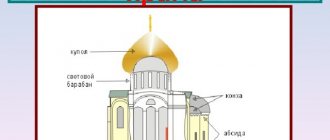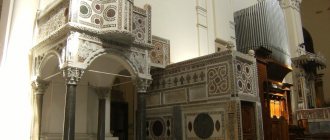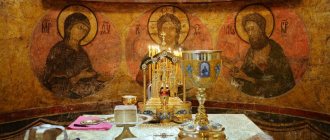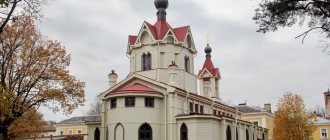The entrance to the temple begins before we cross the threshold of the vestibule. So we reached the temple fence with prayer - what will we see behind it before we enter the temple? The story is told by candidate of art history Lev MACIEL-SANCHEZ, teacher of the Department of Liturgics of PSTGU Alexander TKACHENKO and chief architect of the Association of Restorers, corresponding member of the Academy of Architectural Heritage Andrey ANISIMOV.
Mikhailovskaya Sloboda, Moscow region, Church of the Archangel Michael, Holy Gates, arch. A. Anisimov, 2000
Fishes in the center of Moscow
“The gates in the temple fence are called holy,” says Andrei Anisimov . - They are usually made in three parts. The central gate opens only for bishops and “on the last journey,” and usually we enter through the gate next to it. Sometimes they make not two, but one gate or gate with a gate in it. The tradition of opening the central gates only for the bishop has historical reasons. “If we delve into antiquity,” says Alexander Tkachenko , “we will see that the basilicas had several entrances. This is due to the fact that the Christian community of the city gathered almost in its entirety for holiday and Sunday services, which were led by the bishop. The patriarch, together with the emperor, or the bishop with the local ruler, entered the temple through the central gate, which was called the royal gate, and the people - through the side doors. This custom continued until the 7th century. Then the main type of worship became parish, then the name royal doors was transferred to the gates of the iconostasis. Entering the gate, we often find ourselves in a well-groomed area, with flower beds, benches, a garden, a children's playground, maybe even a pond with fish. “The Sretensky Monastery or the courtyard of the Trinity-Sergius Lavra in Moscow are simply buried in flowers,” Andrei Anisimov gives an example. “You walk in and the smell is different.” Ignorant people say: “The monks got a job with our money, they have fish swimming in the center of Moscow, roses...” But this was not done just for some beauty, this well-kept courtyard is an image of the Garden of Eden. The idea that everything around is sanctified during worship was expressed through architectural means. “In a Byzantine temple, the external and internal spaces are interpenetrated,” says Lev Maciel-Sanchez , “there is no hard boundary between them. The temple is a creation of the Roman, that is, southern, architectural world; around it there were open porticoes and approaches in the courtyards. Byzantium the feeling of a temple was inherited from antiquity, where the temple was the entire gigantic square within the sacred enclosure (a rigid boundary between the sacred and the profane), and the building was a tiny sanctuary where people did not even enter. The early Christian temple was even more “open”, since the coming into the world, death and resurrection of Christ sanctified the whole world. In late Byzantine times, in the 10th - 11th centuries, when civil tendencies in the Church were supplanted by monastic thinking, the space of the church and the space of the world were opposed to each other: churches became small, large courtyards disappeared, and the space of the vestibule was allocated.
Features of the fittings used
Due to the design features of such doors, it is necessary to select special fittings. First of all, we are talking about loops. Since their axis moves slightly outside the vestibule, the following models would be appropriate here:
- Corner card hinges - they look like corners attached to a hinge element; they are attached in the same way as simple straight hinges: one part is fixed on the edge of the door, and the second is screwed to the edge of the canvas and the inside of the vestibule.
- Screw-in hinges are a good alternative to card hinges; they consist of two screw-in pins and a hinge, one part is screwed directly into the box between the rebate and the platbands, the second pin is inserted obliquely into the canvas, touching the rebate.
Screw-in and corner card hinges are well suited for rebated doors
Screw-in hinges are only suitable for durable materials that will not crack under such load.
If a door closer is used, special settings should be made for rebated doors. It must be taken into account that part of the leaf will touch the frame from the outside, so the movement of the door should be smoother at the end of closing.
Rebated doors are an excellent solution for the home, not only from a decorative point of view, but also in terms of useful functionality.
Earthly and heavenly
Having walked through the territory of the temple, we approach the porch. “Dictionaries give different definitions for this word,” says Lev Maciel-Sanchez. “Some say that this is a platform in front of the doors of the temple, others that it is a covered gallery. Most often, the open space on the outside is called the porch, the small space following it is called the vestibule, and the expanded vestibule, in which there may be side churches, is called the refectory. In different eras, in different architectural styles, the porch and staircase were designed differently. For example, the covered staircase of the Church of the Ascension of the Lord in Kolomenskoye is striking in its soaring skyward, while in the Church of the Intercession on the Nerl there is only a small step. “The steps leading to the doors of the temple are an ancient, pre-Christian custom,” explains Alexander Tkachenko. — In the Jerusalem Temple, the priests and Levites climbed the steps to perform sacrifices. The symbolism of the staircase is obvious - our approach to the heavenly world, it means the connection between the earthly and the heavenly. In the Middle Ages, when parish worship was concentrated in the church itself, the ceremonial entry of believers led by the bishop was no longer there; those steps that lead to the altar part acquired significance. A staircase can be very beautiful, but what about those for whom every step is an obstacle? “According to modern standards, when designing a new temple, we are obliged to make either a ramp or an elevator into which a stroller and an accompanying person can go,” says Andrei Anisimov. — This was not the case in the old churches; they are looking for acceptable solutions. For example, during the reconstruction of the Kazan Cathedral on Red Square, the ramp was successfully made; it runs along the wall and does not look random and is not conspicuous.
Valaam, St. Vladimir's Skete, pediment of the main entrance with the Image of the Savior and the prayer of the publican.arch. A. Anisimov, artist A. Brusov
Place for penitents or village club
Next we find ourselves in the vestibule, which is not yet the temple itself. “On Mount Athos, the porch makes up almost half of the temple,” explains Alexander Tkachenko. — Some services of the daily cycle are performed in it, hours, people go there with lithium, as the charter prescribes. In ancient times, the sacrament of baptism and the rite of confirmation were performed in the narthex, after which the newly baptized moved to the main part of the church and joined the faithful to celebrate the liturgy. Practical reasons were of great importance in changing the size and shape of the vestibule. “When everyone became baptized and this function of the vestibule became unimportant,” says Lev Maciel-Sanchez, “it turned into a place of communication or disappeared completely. In Rus', even in pre-Mongol times, porches were connected to the main space of the temple. For example, in the Assumption Cathedral in the Kremlin there is neither a refectory nor a vestibule; you enter directly into the temple. This tradition existed for a long time in monastery cathedrals: the monastery church, unlike the parish church, is devoid of social and economic functions; if in the parish church a huge basement was built for storing food, the vestibule played the role of a village club, then in the monastery there are other buildings for all this. However, we know little about parish churches, since they were mostly wooden, and the earliest wooden church that has reached us was built in 1464. In the 16th century, stone parish churches began to be built; they had small vestibules. “In the Russian tradition, the vestibules are small, they serve to regulate heat exchange, helping to keep the main part of the temple from getting too cold in cold weather,” says Alexander Tkachenko. Gradually, the western part of the Russian temple expanded. “In the 17th century, due to foreign influences in Russia, different spaces gradually appeared to the west of the temple,” says Lev Maciel-Sanchez, “the narthex expands with galleries with side aisles, a familiar pattern arises, when from the narthex we enter the refectory with the right and left side aisles. This was convenient: in winter they served in the chapels, and the large temple was not heated. In Romania they make double porches: external and internal. One of these vestibules is called the “tomb” because its vast space is filled with burials. In Romania and Serbia it becomes a mandatory element of the twelfth-thirteenth century. This never happened in Byzantium, only on Mount Athos. Perhaps from there this tradition came to Serbia, and then to Romania. A small porch can have aesthetic value. “In the Church of Blessed Xenia of St. Petersburg in Bear Lakes, we made a low porch, and it turned out very well,” says Andrei Anisimov. — You first enter a small, cramped room, and then you find yourself in the temple itself, with a tent flying upward. People usually ask in surprise: “How could this volume fit in such a small temple?” The temple is not very big when viewed from the outside. I myself don’t know what’s the matter; probably, while we are passing through the low porch, our perception changes a little.
The difference between doors with and without rebate
First of all, it is necessary to highlight the features inherent in doors equipped with a rebate. Standard models of metal doors have a straight leaf as part of their design. There is no weighting along its edges. When such a door closes only along the perimeter, small gaps remain between the frame and the bar.
Doors equipped with rebates have an additional strip , which extends into the frame at a short distance. From above it is pressed by protruding elements. This ensures maximum sealing of the door product. In addition, the presence of a rebate provides the door with an aesthetic appearance.
In another way, such elements present in metal doors are called quarter or rebate. The standard thickness of the narthex is a quarter of the thickness of the canvas. This is precisely what one of its names is associated with. Another has to do with the method of making doors of this type. is cut by a milling cutter during turning of the rebate .
For the most part, such elements are offered for products made of wood. Some models of MDF canvases also have a rebate. Most often, metal doors and their armored versions are equipped with this element.
Narrow but solemn
“Ideally, the entrances are oriented on three sides,” says Andrey Anisimov.
— The East is Christ, people come to Him from all sides and go out to carry the Good News in all directions. True, the urban planning situation does not always allow this. The main entrance to the temple was always decorated very richly. In Yaroslavl churches of the 17th century it was executed in a very interesting way. There were walkways encircling the temple on three sides, and the entrances were painted, multi-colored, with beautiful kokoshniks, and promising portals. The thickness of the wall is already considerable, but due to the pilasters and half-columns going deeper, it seems even larger, it looks very solemn. The doors themselves are also decorated very richly. The Historical Museum houses 15th-century doors from Suzdal. On them, on a black background, in gold, using casting, chasing, and carving, gospel and hagiographic scenes are depicted. It is interesting that in the ancient tradition, despite the solemnity, the doors are low and rather narrow. The exceptions are royal churches: Sophia in Constantinople, the Assumption Cathedral in the Kremlin. The gates are often crowned with icons of the Savior Not Made by Hands, Christ the Pantocrator, and in Mother of God churches - with the icon of the Intercession. In Byzantine churches they were placed only above the entrance from the vestibule to the temple; now they can be located above both internal and external doors. “The temple itself is holy, it is the house of God, the house of prayer,” says Alexander Tkachenko. — The temple, the throne, the walls of the temple are consecrated in a special way. Since this place is sacred to us, when approaching the temple, we make the sign of the cross and worship. And naturally, the images of the Savior, the Virgin Mary, the saint to whom the temple is dedicated, are placed in front of the entrance; we can worship them before entering the temple. The inscriptions above the entrance also encourage prayer and reverence. These could be quotes from the Gospel: “I am the door” (John 10:7), “I am the light of the world” (John 8:12), “Come to Me, all you who labor and are heavy laden, and I will give you rest” (Matt. 11:28), the words of the publican’s prayer, which is said before entering the temple: “God, be merciful to me a sinner” (Luke 18:13). Irina REDKO
print version
Tags:
Temple
Functions of the vestibule and its advantages
Now everyone understands the difference between rebated doors and conventional products. However, many may wonder whether it is advisable to install door structures equipped with such elements. After all, equipping door structures with these parts leads to an increase in the price tag on the door. In addition, there is a need for additional actions. What does the owner get by purchasing such a door?
Advantages of a rebated door
Designs with a vestibule are more preferable, due to their following advantages:
- Soundproofing. Products equipped with rebates provide tight pressing and eliminate gaps on the sides. As a result, obstacles arise in the way of noise entering the apartment.
- Thermal insulation. By sealing the joints, the passage of heat from the apartment and the penetration of cold from the landing through the opening are eliminated.
- Masking gaps. When installing a regular metal door, gaps may arise between the frame and the leaf, having different sizes, and distortions. All this worsens the aesthetics of the external appearance of the door structure. Thanks to the porch, all these shortcomings can be hidden.
- Aesthetics. The presence of a vestibule in the design provides the door with a special charm inherent in classic interiors. In addition, such an element performs a decorative function and adorns the product.
You should not refuse to purchase a door design with a rebate because of stereotypes and the opinion that such a door is not suitable for modern interiors. In some cases, such a design fits harmoniously into the design of the room, perfectly complementing its interior.










